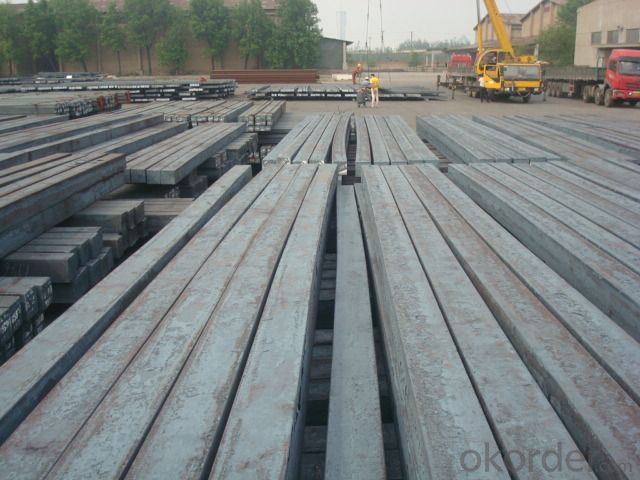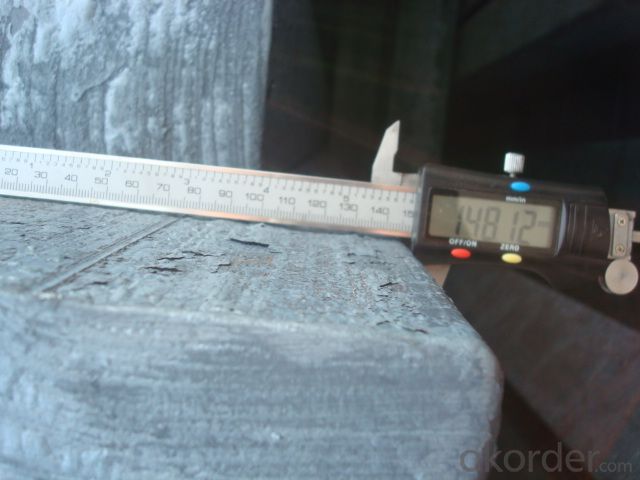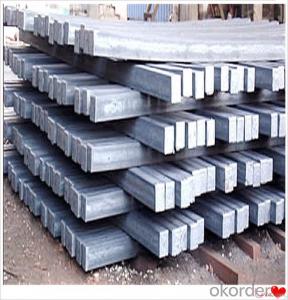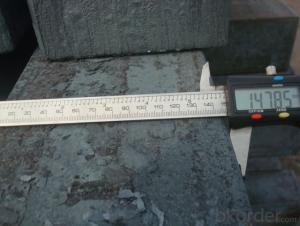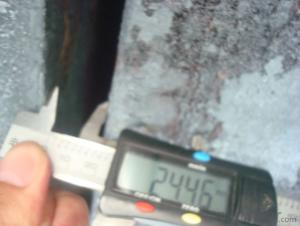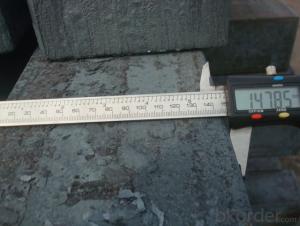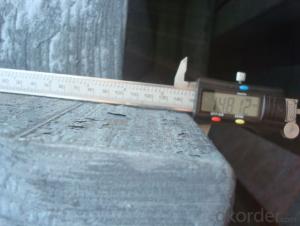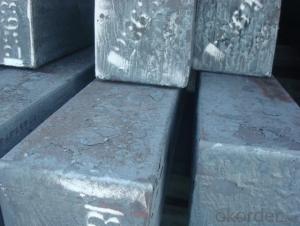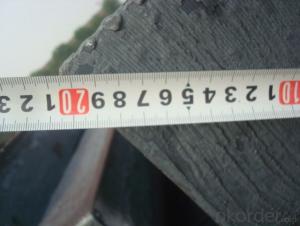Steel Bloom/Billet Manufactured by Blast Furnace
- Loading Port:
- Tianjin
- Payment Terms:
- TT OR LC
- Min Order Qty:
- 1000 m.t.
- Supply Capability:
- 10000 m.t./month
OKorder Service Pledge
OKorder Financial Service
You Might Also Like
Steel Bloom/Billet Manufactured by Blast Furnace
1.Structure of Steel Bloom/Billet Manufactured by Blast Furnace
Steel Billets Manufactured by Continue Casting is the raw material of all kinds of steel mill. Billet section of square, round, flat, rectangular and abnormity, etc Several, mainly related to shape of rolled products. Simple rolled section steel, choose cross section of square billet or rectangular billet. rolling The sector products such as flat steel, Angle steel, select the rectangular billet or slab. Had better profiled billet when production beams, channels, and in rolling process Lines and improve the yield. The raw material of round billet is the production of seamless tube.
2.Main Features of Steel Bloom/Billet Manufactured by Blast Furnace.
Steel Billets Manufactured by Continue Casting section size should meet the requirements of rolling deformation and finished product quality, but also roll strength and biting condition of restrictions. General steel Billet section height H. And the roll diameter D The ratio of the ( namely H/D) Should be less than or equal to zero 0.5 . Length of steel billet by finishing temperature, Rolling time and the length of the product Or times ruler. When heated too long accident prone to bump the furnace wall of steel, too short, furnace bottom utilization rate is not high, influence the heating furnace production. For the production Choose a variety of steel and steel billet, should consider the affinities of billet, as far as possible in order to improve the productivity of the roughing mill, simplify the stock management of workshop.
There are three shapes of the steel billets: square billet, slab, rectangular billet The Chinese billet, rectangular billet is mainly suitable for rolling hot rolled strip, building reinforced bar, Ordinary wire, high speed wire rod and various small profile. Of the slab are mainly used for rolling plate and hot coil sheet.
3. Steel Bloom/Billet Manufactured by Blast Furnace Images
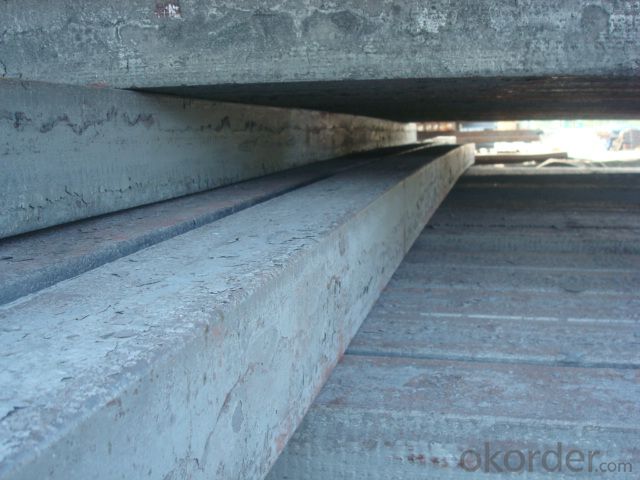
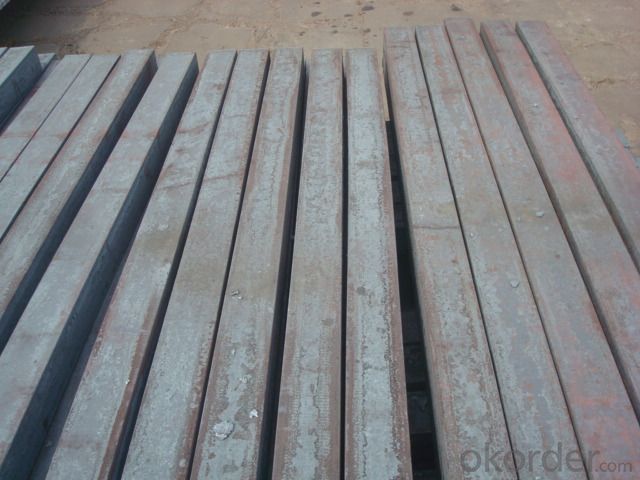
4. Steel Bloom/Billet Manufactured by Blast Furnace Specification
Steel Bloom/Billet Manufactured by Blast Furnace rolled steel, after processing can be used for mechanical parts, forging parts, processing all kinds of steel, steel Q345B channel steel, wire rod is the role of the billet. Steel billet is used in the production of semi-finished products, generally cannot be used directly for the society. Steel billets and steel are strictly divided into standard, cannot decide to whether the business enterprise of the final product, and according to unified standards to perform the whole society. Typically, billet and the steel is relatively easy to distinguish, but for some steel billet, and have the same specification and same steel purposes (such as rolling tube billet), whether can be used for other industries, whether through steel processing process, whether through a finished product rolling mill processing to distinguish
Material standard The editor Range of thickness: 150-240 - mm + / - 5 mm width range: 880-1530 - mm + / - 20 mm Length: 3700-10000 - mm + / - 500 - mm Cross-sectional size: 64 * 64; 82 * 82; 98 * 98; 124 * 124; 120 * 150; 152 * 164; 152 * 170 mm Length: 9000 mm Section of tolerance: billet: 1.0 + / - 2.0-1.0 + / - 1.0 mm slab: width: + / - 2.0 mm thickness: + / - 3.0 mm The length tolerance: + / - 200 mm Section diagonal tolerance: 3.5-8.0 MM Billet section size protrusions requirements: < 1242 mm, do not allow; > = 1242 mm, < = 2 mm 1242 mm, < = 3 mm Beheading (shear) extension deformation: < 1242 mm billet: no control; The slab: < = 15 mm Surface tilt: no more than billet section 0.1 Bending: every 1 m length is not more than 10 mm The distortion: length < = 5 m, < = 11. ; The length of the < = 7.5 M, < = 5. Material % 3 sp/PS chemical composition: C Mn Si S P
5.FAQ of Steel Bloom/Billet Manufactured by Blast Furnace
We have organized several common questions for our clients,may help you sincerely:
①How about your company?
A world class manufacturer & supplier of castings forging in carbon steel and alloy steel,is one of the large-scale professional investment casting production bases in China,consisting of both casting foundry forging and machining factory. Annually more than 8000 tons Precision casting and forging parts are exported to markets in Europe,America and Japan. OEM casting and forging service available according to customer’s requirements.
②How to guarantee the quality of the products?
We have established the international advanced quality management system,every link from raw material to final product we have strict quality test;We resolutely put an end to unqualified products flowing into the market. At the same time, we will provide necessary follow-up service assurance.
③What is the advantage of the continue Casting steel billet comparing to the die casting steel billet?
Compared with die casting, continuous casting has the advantages of: 1. To simplify the Steel billet The production process 2. Improve the metal yield 3. Improve the quality of the billet 4. Reduces the steel worker's labor intensity 5. Save energy and reduce consumption
Steel billet is produced by the method of through three processes: It is through the steelmaking system of continuous casting equipment, directly by the molten steel pouring into billet; The second is the steelmaking system in the production of steel ingot casting billet through system of steel rolling rolling equipment or processing of steel semi-finished products; Three is the steelmaking system production of steel ingot by forging the semi-finished product processing equipment.
- Q: What are the main types of steel billet rolling mills?
- The main types of steel billet rolling mills include continuous, semi-continuous, and reversing mills.
- Q: How are steel billets preheated before processing?
- Steel billets are typically preheated before processing using a variety of methods such as induction heating, gas-fired furnaces, or electric resistance heating. These techniques raise the temperature of the billets to an optimal level, ensuring they are ready for further processing, such as rolling or forging.
- Q: How are steel billets used in the manufacturing of furniture and fixtures?
- Steel billets are an essential component in the manufacturing of furniture and fixtures due to their versatility and durability. These billets, which are semi-finished metal products, serve as the raw material for creating various components of furniture and fixtures. One common use of steel billets in furniture manufacturing is for creating frames and structural supports. The billets are shaped and cut into specific dimensions to form the framework of chairs, tables, and other pieces of furniture. The strength and rigidity of steel make it a preferred choice for ensuring the stability and longevity of these products. In addition to frames, steel billets are used for producing hardware components of furniture and fixtures. This includes hinges, locks, drawer slides, and other mechanisms that require strength and precision. By using steel billets, manufacturers can ensure that these components can withstand the wear and tear associated with daily use. Steel billets are also utilized in the production of decorative elements in furniture and fixtures. They can be molded, bent, or welded into various shapes and designs to add aesthetic appeal to the final product. These decorative elements may include trimmings, accents, or ornamental details that enhance the overall appearance of furniture and fixtures. Furthermore, steel billets are often used in the manufacturing of fixtures such as shelving units, display racks, and storage systems. The durability and load-bearing capacity of steel make it an ideal material for constructing these items, ensuring that they can withstand heavy loads and provide long-term support. In summary, steel billets play a crucial role in the manufacturing of furniture and fixtures. They are used to create frames, hardware components, decorative elements, and various types of fixtures. Their strength, durability, and versatility make them an essential raw material for producing high-quality and long-lasting furniture and fixtures.
- Q: How are steel billets used in the production of reinforcement bars?
- Steel billets are a crucial component in the production of reinforcement bars, also known as rebar. These billets, which are essentially semi-finished steel products in a rectangular or square shape, serve as the starting point for the manufacturing process. To produce reinforcement bars, steel billets are first heated in a furnace to a temperature above their recrystallization point. This process is known as hot rolling. The heated billets are then passed through a series of rollers, which gradually reduce their cross-sectional area and elongate the material. As a result, the billets are transformed into long, slender bars with the desired dimensions and mechanical properties. During the hot rolling process, the steel billets undergo significant plastic deformation. This deformation causes the grains within the material to realign and form a more uniform and compact structure. This refined microstructure enhances the strength and durability of the reinforcement bars, making them suitable for use in construction projects where high tensile strength is required, such as in reinforced concrete structures. The size and shape of the steel billets used in the production of reinforcement bars vary depending on the specific requirements of the end product. It is important to note that the quality of the billets is a critical factor in determining the quality of the final rebar. Therefore, manufacturers must carefully select and inspect the billets to ensure they meet the necessary specifications and standards. In summary, steel billets are essential in the production of reinforcement bars as they are transformed through the hot rolling process into the desired shape and dimensions. The resulting rebar possesses improved strength and durability, making it suitable for reinforcing concrete structures and ensuring their structural integrity.
- Q: What are the different types of non-destructive testing methods used for steel billets?
- Steel billets undergo various non-destructive testing methods to ensure their quality and integrity without causing any damage or alteration. Commonly used techniques include: 1. Ultrasonic Testing (UT): High-frequency sound waves are utilized to detect internal defects like cracks, voids, and inclusions that may affect the billet's performance. 2. Magnetic Particle Testing (MPT): Magnetic fields and particles are employed to identify surface and near-surface defects such as cracks and seams that may be invisible to the naked eye. 3. Eddy Current Testing (ECT): By measuring changes in electrical conductivity and magnetic fields, ECT can detect surface and near-surface defects like cracks and corrosion. 4. Visual Inspection: This basic method involves a thorough visual examination to identify visible defects such as surface cracks, dents, or irregularities. 5. Penetrant Testing (PT): A liquid or fluorescent dye is applied to the billet's surface, seeping into any surface defects. After removing excess dye and applying a developer, defects like surface cracks and porosity become visible. 6. Radiographic Testing (RT): Using X-rays or gamma rays, RT penetrates the billets to produce images revealing internal defects like cracks, inclusions, and voids. Employing a combination of these techniques, manufacturers ensure the safety and performance of steel billets by identifying and rectifying potential defects or inconsistencies.
- Q: How are steel billets used in the manufacturing of industrial tools?
- Steel billets are used in the manufacturing of industrial tools as they serve as the initial raw material for various tool components. These billets undergo a series of processes such as heating, forging, and machining to shape them into the desired tool parts, such as blades, bits, or molds. The superior strength and durability of steel make it an ideal material for industrial tools, ensuring their ability to withstand heavy usage and challenging working conditions.
- Q: How are steel billets coated or painted?
- Steel billets can be coated or painted through several methods. One common technique is hot-dip galvanizing, where the billets are immersed in a bath of molten zinc. This process forms a protective zinc coating on the surface of the steel, preventing corrosion. Another method is electroplating, which involves the deposition of a thin layer of metal, such as zinc or nickel, onto the billets using an electric current. Additionally, steel billets can be painted using various coating systems, such as powder coating or liquid paint, to provide a decorative finish or additional protection against rust and environmental factors.
- Q: What are the different types of defects that can occur in steel billets?
- There are several types of defects that can occur in steel billets. These defects can occur during the manufacturing process or as a result of external factors. Some of the common types of defects include: 1. Surface defects: These defects occur on the outer surface of the billet and can include scratches, pits, scabs, scale, and cracks. Surface defects can be caused by handling, improper cooling, or contamination during manufacturing. 2. Internal defects: These defects occur within the body of the billet and are not visible on the surface. They can include voids, porosity, inclusions, and segregation. Internal defects can be caused by improper solidification, improper casting, or impurities in the steel. 3. Dimensional defects: These defects occur when the billet does not meet the desired dimensions or tolerances. Dimensional defects can include variations in length, width, thickness, or straightness. These defects can be caused by improper rolling, uneven cooling, or misalignment of the equipment. 4. Mechanical defects: These defects affect the mechanical properties of the steel billet. They can include improper grain structure, low hardness, brittleness, or poor toughness. Mechanical defects can occur due to improper heat treatment, incorrect alloy composition, or inadequate rolling processes. 5. Weld defects: In case of welded billets, defects related to the welding process can occur. These defects can include lack of fusion, incomplete penetration, porosity, or cracks in the weld zone. Weld defects can be caused by improper welding parameters, inadequate preparation, or contamination during the welding process. It is important to detect and address these defects to ensure the quality and integrity of the steel billets. Various inspection techniques such as visual inspection, ultrasonic testing, magnetic particle testing, or radiographic testing can be employed to identify and classify these defects.
- Q: What is the role of steel billets in the manufacturing of storage systems?
- Steel billets play a crucial role in the manufacturing of storage systems due to their unique properties and versatility. These billets are essentially semi-finished steel products that are used as raw materials in various manufacturing processes. The primary role of steel billets in the manufacturing of storage systems is to serve as the base material for fabricating different components, such as shelves, frames, supports, and racks. The high strength and durability of steel make it an ideal choice for these applications, as it can withstand heavy loads and provide long-lasting performance. Steel billets are typically melted and cast into specific shapes, such as square or round, to suit the requirements of the storage system design. These billets undergo further processing, such as hot rolling, to transform them into the desired dimensions and form. This process helps to refine the steel's microstructure, enhancing its mechanical properties and ensuring consistent quality. The versatility of steel billets allows manufacturers to customize storage systems according to specific needs. By shaping and welding steel billets, manufacturers can create storage systems with different configurations, sizes, and load capacities. This flexibility enables the production of storage systems that are tailored to meet various industrial and commercial applications, ranging from warehouses to retail stores. Moreover, steel billets offer excellent resistance to corrosion, making them suitable for storage systems used in both indoor and outdoor environments. This resistance ensures that the storage systems maintain their structural integrity and aesthetics over time, even in harsh conditions. In summary, steel billets play a vital role in the manufacturing of storage systems by serving as the raw material for various components. Their strength, durability, versatility, and corrosion resistance make them an ideal choice for fabricating storage systems that can withstand heavy loads, provide long-lasting performance, and meet specific design requirements.
- Q: What are the different shapes of steel billets?
- Steel billets can come in various shapes, including square, round, rectangular, and hexagonal.
Send your message to us
Steel Bloom/Billet Manufactured by Blast Furnace
- Loading Port:
- Tianjin
- Payment Terms:
- TT OR LC
- Min Order Qty:
- 1000 m.t.
- Supply Capability:
- 10000 m.t./month
OKorder Service Pledge
OKorder Financial Service
Similar products
Hot products
Hot Searches
Related keywords


